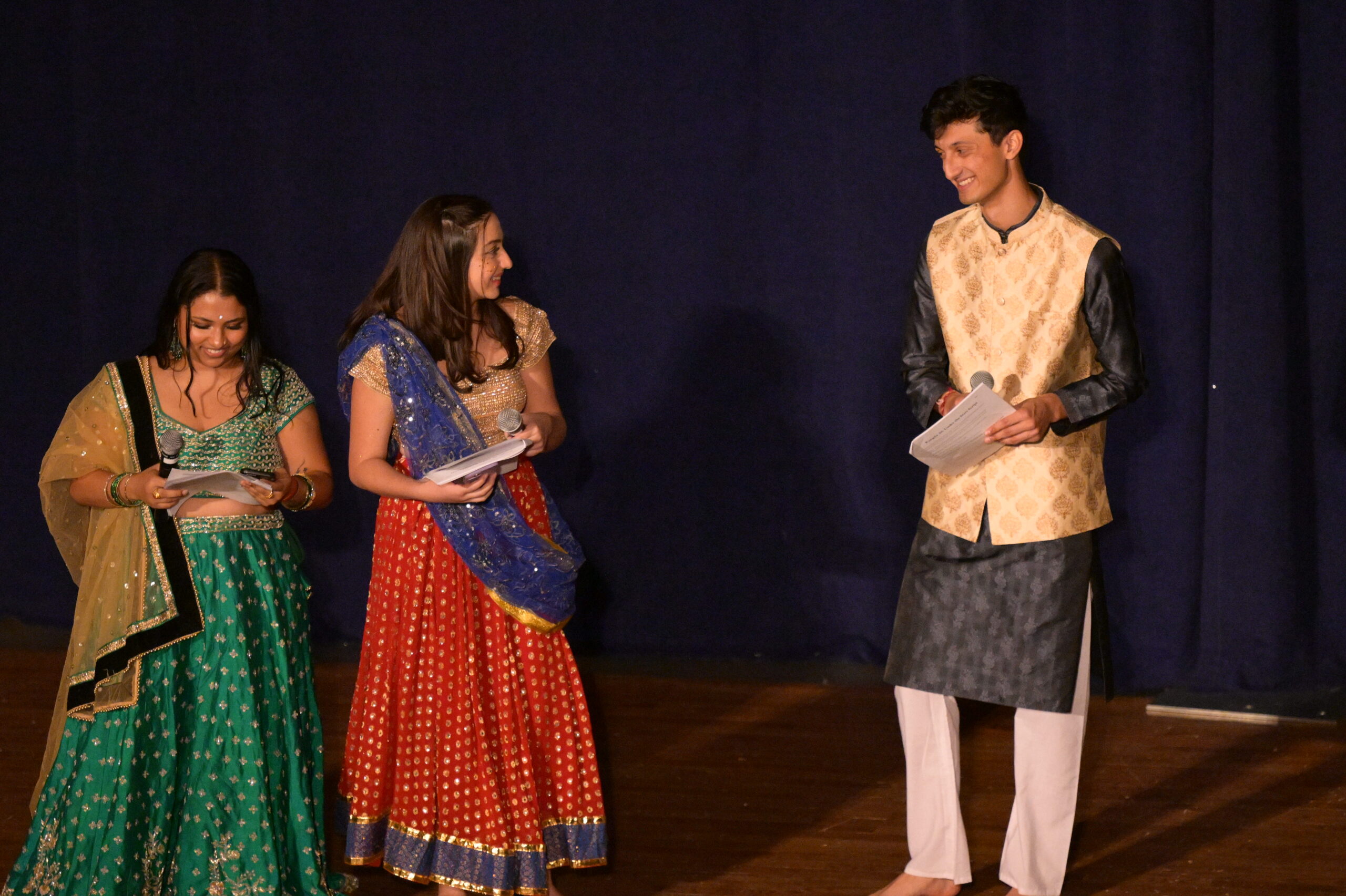Year after year, Georgetown students craft centers of South Asian culture that blend creativity, education, and philanthropy. When over 500 students filled Lohrfink Auditorium to join Rangila 30 on Sept. 4, 2024, we witnessed the power of what 30 years of Rangila coordinators have built, but also the absence of what the university itself has not. Despite a commendable effort to uplift and celebrate South Asian student culture, there remains a striking lag in Georgetown’s institutional commitment to South Asian academic scholarship.
This is our reflection, and our call to action.
We all came across Rangila in different ways. Rushil Vashee (SFS ’25) learned about it in office hours with President DeGioia during his first semester at Georgetown. Alison Karki (CAS ’25) mentioned Rangila in her alumni interview even before committing to Georgetown. Rania Khan (SFS ’26) found Rangila at a time when she longed for a sense of home on campus as an international student. Still, one thing was true for all of us: ever since we discovered Rangila, we wanted to become as involved as possible.
Earlier this semester, the three of us wrapped up our time as the coordinators of Rangila 30. As coordinators, we had every opportunity to bring our visions to the stage. We revived Afro Fusion after a decade, introduced a Saturday matinee show, and raised over $81,000 for Little Sisters Fund (LSF), a nonprofit that empowers girls in Nepal through education and mentorship. We even outlined all of Rangila 30’s milestones in our first-ever Annual Report.
Outside of the value Rangila has brought to our lives, it has also engaged a broad set of the Georgetown community through its radical accessibility. Because Rangila has no tryout process and requires minimal commitment for most participants, it draws students across all class years and experience levels.
While it’s usually difficult for students in their last year to join a new club, 40% of Rangila 30’s performers were Georgetown seniors. Moreover, over 60% of our performers were first-time Rangila participants. Rangila encourages anyone, at any point in their college journey, to step out of their comfort zone and engage in something new. Critically, each of these people brought the commitment, work-ethic, and joy that makes Rangila such a special production. Even when we asked a lot of our performers—such as blocking off two full days to perform the show three times—people showed up with more adrenaline than burnout.
And even when Rangila 30 expanded the showcase to an unprecedented scale, students jumped at the opportunity to join. When our Philanthropy Board expanded the size of our on-campus fundraising events, more students showed up to each one than ever before. When our Logistics Board expanded our online presence to include new social media platforms and a website, our digital engagement levels skyrocketed. Rangila fosters this level of dedication because it serves students in many capacities, whether it be a creative outlet, a light-hearted escape from Georgetown’s otherwise intense club culture, or a cultural home away from home.
Our 400 performers have uniquely positioned Rangila to fill several gaps in Georgetown’s South Asian education, including engagement with underrepresented regions in South Asia. When choreographing a “regional dance,” for example, we always made a concerted effort to teach performers about the vibrant history and culture that inspires the dance. Alison invited her dancers to a momo-making night for “Lekali Nepali,” Rushil helped to integrate all four of the major languages of South India into “Southern Suvai,” and Rania spotlighted Nazia Hassan, a Pakistani popstar, when choreographing “Old School.”
Rangila 30 “Southern Suvai” choreographers Pravallika Palwai (SOH ‘26), Keerthana Ramanathan (SOH ‘26) and Vaibhavi Mahajan (SFS ‘26) also championed this commitment to education in their dance practices.
“At our first practice, we gave a brief presentation on the rich and diverse nature of South Indian culture. We felt it was important to ground the choreography in cultural understanding, especially since our dance pays homage to South India’s roots,” Palwai said. “We wanted the dancers to understand this context so they could connect more deeply with the performance and the culture it’s inspired by.”
Beyond the performances, Rangila’s philanthropic mission reinforced its educational goal. Our annual philanthropy competition honed in on Georgetown students’ competitive spirit by incentivizing both attendance at fundraising events and donations to our charity partner through a point system. Essentially, it rewarded Rangila performance groups and specific participants who invested time into learning about a region-specific issue in South Asia, whether it be women’s education in Nepal, food insecurity in Pakistan, or any of our other initiatives. Throughout Fall 2024, we bridged the awareness gap through educational presentations at practices, roundtable discussions with LSF co-founder Trevor Patzer, and even a keynote address at one of our shows.
Rangila is one of many student-run South Asian events at Georgetown, joined by the likes of the South Asian Society’s language hours, the Hindu Student Association’s mandir visits, and the Muslim Student Association’s iftars. These student-led initiatives drive South Asian studies across academic, cultural and religious topics at Georgetown University.
Now, we believe Georgetown University as an institution must supplement this existing programming with more cohesive South Asian scholarship.
Nikash Harapanahalli understands the urgent need for more South Asian representation in syllabi. Currently an M.A. candidate with a focus in Asian Studies, he led a petition as an undergrad for GU to begin offering a South Asian Studies certificate in 2022. While that certificate now exists, Harapanahalli echoes our vision for further institutional change.
“There needs to be a fundamental redressing of how the school approaches South Asian studies,” Harapanahalli said. “South Asian students have made their community. The university, in contrast, has very little formal engagement with South Asia in a robust manner.”
To better bridge this gap, we urge Georgetown University to drive this engagement in two ways.
First, the Walsh School of Foreign Service should structure South Asian Studies around an interdisciplinary, multiperspectival core curriculum up to par with other regional studies such as the African Studies Program at this university and others around the United States.
Since its founding in 2022, the South Asian Studies department has successfully brought in numerous exceptional faculty and speakers. Already, these steps have been immensely valuable to Georgetown students.
“The professors we have hired are outstanding, and the classes they are teaching are also outstanding,” Shareen Joshi, an SFS professor, affirmed. “But I don’t think there’s enough. You need to invest more in South Asian studies. You need to look at your curriculum and make sure you keep a balanced perspective.”
South Asian Studies at Georgetown University struggle with a “coherence problem,” where students have access to courses on South Asian religion, politics, culture, and economics, but lack an intentional structure and depth.
Therefore, we urge the Asian Studies Program to follow the lead of other robust regional studies at the university: the African Studies Program has a core curriculum grounded in multiple disciplines—history, government and anthropology to name a few—and provides a variety of electives that focus on the different region-specific issues, socio-political movements, and manifestations of faith within Africa.
When Georgetown teaches the caste system, it should also mandate an in-depth inquiry into socio-religious anti-caste movements. Where it teaches South Asian nationalism, it should include a critique of its exclusions and highlight the activism that resists it. Where it teaches Hindu philosophy, it should present Dalit and Ambedkarite critiques, which expose the moral fault lines in inherited hierarchies and demand a theology of justice that centers the most marginalized.
If we are to heed the Jesuit call to “seek the truth as a way to deepen our understanding of the world around us,” a certificate program like South Asian Studies must enable and encourage students to engage with multiple perspectives within its curriculum. We can’t understand U.S. or European history without reckoning with complex counter arguments and theories—neoliberal, conservative, and constructivist. How, then, can we understand South Asian regions through an incoherent blend of courses, no matter how extensive the offerings?
The second way we urge Georgetown to act is by investing in sustained South Asian programming beyond the classroom—recurring speaker series, community-based research initiatives, language preservation projects, and deeper faculty-student collaboration. A long-term commitment means treating South Asian Studies with the same consistent investment that has built robust regional studies programs at Georgetown and other schools.
A fundamental uptick in engagement with South Asian Studies will not happen overnight—in fact, it took dedicated efforts over multiple decades for China Studies to grow into the robust college academic field that it is today. This slow-growing stems in large from an absence of intensive engagement with academia even in the region being studied.
Professor Joshi emphasized that, as a lingering loss from colonialism, research on South Asia is notably absent even within the Indian subcontinent.
“Most universities even in South Asia—specifically Bangladesh, India, and Pakistan—don’t have a deep curriculum or literature of South Asian studies because they were colonized lands,” Professor Joshi said. “Decolonization is not an event but a process that spans generations. Our academic institutions are still working to recover and reconstruct knowledge systems that were historically marginalized.”
To contribute to this decolonizing effort, a long-term commitment to prioritize South Asian programming must be shared between the university, its faculty, and its students and encourage active participation consistently, even when engagement may dip temporarily.
On the other end, students must recognize that participation inside and outside the classroom is vital. Showing up, performing, and attending are all acts of engagement and keep South Asian cultural spaces alive. Our active presence as students is a form of advocacy—especially in a time where intercultural engagement and collaboration are of utmost importance.
“When students mobilize and find professors they can work together with, the two can create magic,” Professor Joshi emphasized. “Professors can create reading lists, small one-credit courses, discussion groups, book clubs.”
The onus to preserve and expand South Asian Studies should be shared by the university and its students. Georgetown University has taken impressive strides to hire faculty and develop courses for South Asian students, which is not the norm for many U.S. universities. And, grounded in its Jesuit values, it has the basis to continue supporting a holistic education for a broad set of students.
“We all have a habit of complaining that Georgetown doesn’t live up to its espoused values,” Professor Joshi added. “But I think we have to appreciate that having espoused values gives you a place to go back to.”
Rangila grew to be more than just a showcase to us: it illuminated the incredible potential of Georgetown to “educate the whole person” through critical scholarship and cultural engagement. For years, student-led South Asian initiatives at Georgetown have offered students an opportunity to practice regional languages, understand South Asian heritages, and interrogate non-Western histories. Now, it’s time for Georgetown to meet us on the other side of the curtain and bring a rigorous South Asian education to the classroom.





